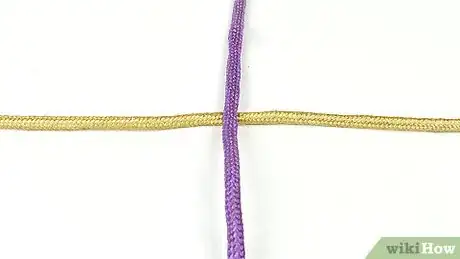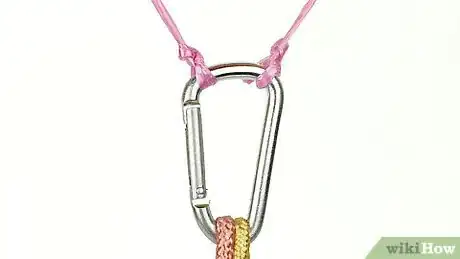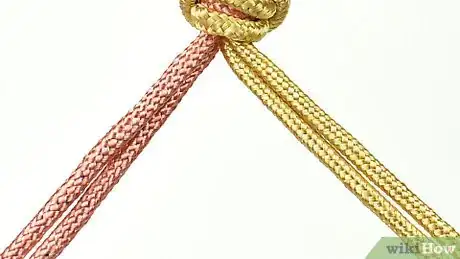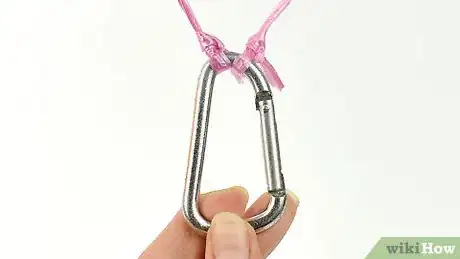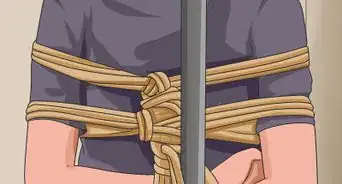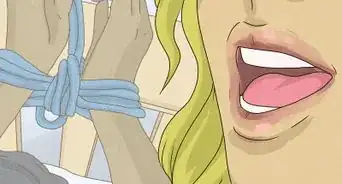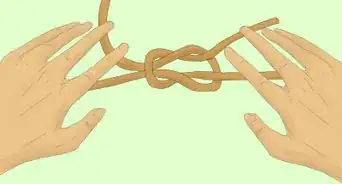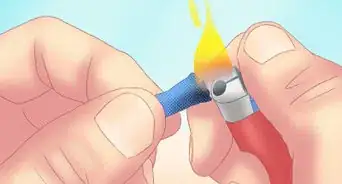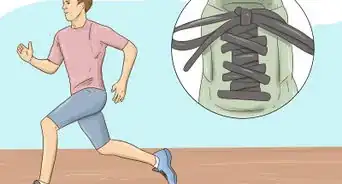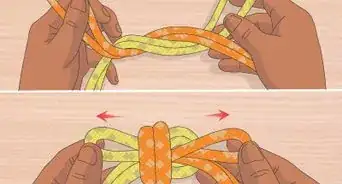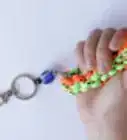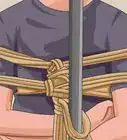wikiHow is a “wiki,” similar to Wikipedia, which means that many of our articles are co-written by multiple authors. To create this article, 88 people, some anonymous, worked to edit and improve it over time.
The wikiHow Video Team also followed the article's instructions and verified that they work.
This article has been viewed 745,613 times.
Learn more...
Whether for yourself or for a gift for a friend, lanyards are cute and fun to make and do not require a lot of supplies. Also, lanyards have a variety of uses, such as offering a great way to secure keys, cell phones, badges, or whistles. There are a lot of different varieties of lanyards you can make, some more advanced than others, but here are a few ideas to get you started on this enjoyable hobby.
Steps
Weaving a Two-Strand Crown Sinnet (Box/Square) Lanyard
-
1Cut two equal lengths of material. You can cut them as long as you'd like, but bear in mind that with thick craft lace about 3 feet (1 m) of craft lace will yield about 3 inches (7.6 cm) of lanyard.
- Thinner gimp and boondoggle laces will yield more length in the final product.
- Using two different colors will be easier at first while you're learning the crown sinnet method.
-
2Find the center of each strand. All you need to do to find the centers is fold the strands in half until the ends are even. Then hold your thumb and finger around the centers so you don't forget where they are.Advertisement
-
3Overlay the two strand centers. Lay the two centers over each other on the top of your working station, arranging the strands in a plus sign.
Securing your lanyard strands at the end with a clip or keychain may make it easier to thread. Slip it onto the bottom strand and gently move it toward the center. It doesn't have to be exactly at the center right now, you can adjust it later.
-
4Fold up two loops with the bottom strand. Holding one finger down on the center for the entire first stitch so that the two strands stay where they are, use your other hand to grab one end of the bottom strand. Draw it up over the center, creating a large loop. Grab the other end of the bottom strand and do the same thing.
- Do not cross the strands as you draw up the loops; just make sure they both loop over the finger that's holding down the center.
-
5Weave one end of the top strand through the loops. Grab one of the ends of the top strand, draw it toward the center, and simply weave it over the first loop it encounters but under the second loop.
- Your two ends for the top strand should now be facing the same direction.
-
6Weave the other end of the top strand through the loops. Grab the other end of the top strand, draw it toward the center, and simply weave it over the first loop it encounters but under the second loop.
- Make sure the strand you're weaving isn't the one you just weaved through a loop and draw it toward the center.
- Note that the loop your second top strand went under is the loop your first top strand went over.
-
7Re-place your finger on top of your first stitch. Remove your finger from the center and place it on top of the first stitch (the two weaves you just completed). Use your finger to steady the center while you tighten the stitch.
-
8Tighten the stitch. With your free hand (the one not holding down the stitch), gently tug on each strand in succession to tighten the stitch. You might have to go around a few times to get it tight enough.
Flip the stitch over and make sure your hook is in place. It should be directly over the "box" you just created. Continue tightening the stitch after you move the hook.
-
9Begin your next stitch. Repeat what you did for the first stitch: using the same color that was the bottom strand during the first stitch, draw up two non-crossing loops again. Then, with one end of the top strand, go over the first loop and under the second one; repeat this with the other end of the top strand. Tug the strands to tighten the stitch.
-
10Repeat the loop/weave/tighten process. You will continue this same process until until you almost run out of lace. Stop before you run out completely, because you may need to make a final stitch to secure the end.
-
11Finish your lanyard. How you finish the lanyard will depend on what material you're using.
- If you're using a thread-based material, such as craft lace, simply cut the ends close to the lanyard and burn them with a match or secure them with crazy glue.[1]
- If you're using gimp or boondoggle material, you'll need to do a finishing "stitch." Loosen the loops of your last stitch a bit first. Then take one of your strands and pull it through the loop of the other strand of the same color, going under the same-color strand as well as the different-colored strand beneath it. Finally, pull your strand up through the center of the lanyard. Repeat this for all four strands, pulling each strand tight when they're all through, and then trim the strands to your desired length.
Weaving a Four-Strand Braid Lanyard
-
1Cut two equal lengths of material. Both strands should be 3 to 4 feet (1 to 1.2 m) long, and, to easily differentiate between strands, you will probably want to choose different colors.
This method requires only two pieces of material: the "four" comes in when you double over the strands by threading them through your lanyard hook.
-
2Thread both strands through your lanyard hook. Draw the hook up to the center of your strands by doubling the strands over until their ends line up.
-
3Secure your lanyard hook. Securing your lanyard hook will make braiding easier. To secure your lanyard hook, you can hook it to a tack on a wall or a table, pinch it between your knees, or simply tape it down.
Securing your lanyard hook allows you to maintain a tight tension while you're braiding, making the process easier.
-
4Knot the strands to the hook. Pull the strands together, grab them all from the bottom, twist your wrist so they create a loop together, and draw their loose ends through the loop. Maneuver the knot near your lanyard hook and continue to pull the loose ends through the loop to tighten.
-
5Separate your strands. Separate the strands by their color, keeping the same-colored ones together, and holding each pair in a different hand.
-
6Cross your same-color strands. In each hand, take the strand on the right and cross it over the left. You should then have two, crossed, same-color strands in each hand.
-
7Cross your two, middle, different-colored strands. With your two pairs of strands in each hand, cross the two, middle, different-colored strands by bringing the left middle strand over the right middle strand.
-
8Repeat this process. You will now repeat crossing the strands in each hand and crossing your middle strands until you almost run out of material. Stop before you do run out, however, because you will need to make a final stitch to secure the end.
- You may now disregard the color-specific aspects of the process (which were included for clarity) because what matters is the position and sequence of the weaving.
-
9Tie a knot. Just before you run out of material, as close as possible to your braid, tie a knot at the end by wrapping all four strands around your forefinger and drawing their ends through the loop (that was created around your finger). Then pull to tighten. (See the video below for more help with the modified braid.)
Weaving a Diamond Braid Lanyard
-
1Cut two equal lengths of material. You can cut it as long as you'd like, but keep in mind that the thicker your material, the smaller the length. Additionally, you should use different colors to make your lanyard look prettier and to help you differentiate between your strands as you weave.
- For boondoggle, 3 to 4 yards is a good length for a beginner's lanyard.[2]
-
2Secure your lanyard hook. To secure your lanyard hook, you can use a push-pin on a desk or a wall, tape it down, or pinch it between your knees. The more secure, the better, as you will want to be able to tug on your strands of material throughout this process to tighten the stitching.
-
3Thread both strands through your lanyard hook. Draw your lanyard hook up to the center of your strands by doubling the strands over it until their ends line up. You will need to arrange your strands so that the two halves in back are positioned to the left of the two halves in front.[3]
-
4Pull the right-most strand. Your right most strand is one of the halves in front, so pull it around behind the two, center strands and on top of the center-left strand.[4]
-
5Pull the left-most strand. Pull the left-most strand around behind the two, center strands and on top of the center-right strand.[5]
-
6Tighten your braid. Pull your strands to tighten the weave you have just made. Your lanyard hook will need to be secure for you to do this effectively.
-
7Repeat weaving. Repeat the exact same process with whichever strands are in the positions designated (e.g. right-most, center, left-most). You will repeat this process until you are satisfied with the length or you almost run out of material.
- Stop before you run out of material, as you will need to tie-off your end to secure your stitching.
- Do not twist your strands as you bend them around behind the others, otherwise it will disrupt the diamond pattern.[6]
-
8Finish your lanyard. When you are finished, tie a granny knot using the two, uppermost strands: that is, the two strands that are higher up the braid, one of which would have been your next strand to weave. [7]
A granny knot basically consists of two half knots: cross the strands, wrap your top strand around your back strand, and then repeat this for the ends of the half knot you've just created.
Community Q&A
-
QuestionWhat is the string to make the lanyard called?
 Beth H.Community AnswerIt is called a gimp.
Beth H.Community AnswerIt is called a gimp. -
QuestionI do not know how to start a box. Can you help?
 Community AnswerTake the strands and find the center. Make a plus sign out of them, turning it into four strands. The top strand will need to be folded down, fold your left strand toward the right, move the bottom strand up, and take the final strand over the first strand and under the other. That is how to start the box braid, and you just keep doing the same steps with the 4 strands until you are done. If a visual will help, search it on YouTube.
Community AnswerTake the strands and find the center. Make a plus sign out of them, turning it into four strands. The top strand will need to be folded down, fold your left strand toward the right, move the bottom strand up, and take the final strand over the first strand and under the other. That is how to start the box braid, and you just keep doing the same steps with the 4 strands until you are done. If a visual will help, search it on YouTube. -
QuestionHow would I do the diamond braid?
 Community AnswerIf you know how to do the box braid, you do the same steps. However, instead of keeping the strands straight, pull them at an angle and it will be the diamond braid. If that doesn't help, just look up some videos, as there are multiple ways to do it.
Community AnswerIf you know how to do the box braid, you do the same steps. However, instead of keeping the strands straight, pull them at an angle and it will be the diamond braid. If that doesn't help, just look up some videos, as there are multiple ways to do it.
Warnings
- Be careful if you use a lighter to end your crown sinnet.⧼thumbs_response⧽
Things You'll Need
- Lanyard cord, craft lace, gimp or boondoggle strings.
- Scissors
- Measuring tape (optional)
- Lanyard hook (optional, for ease of tightening your stitchings)
- Lighter (optional)
References
- ↑ https://snapguide.com/guides/make-a-spiral-lanyard/
- ↑ http://www.boondoggleman.com/prj_diamond_braid.htm
- ↑ http://www.boondoggleman.com/prj_diamond_braid.htm
- ↑ http://www.boondoggleman.com/prj_diamond_braid.htm
- ↑ http://www.boondoggleman.com/prj_diamond_braid.htm
- ↑ http://www.boondoggleman.com/prj_diamond_braid.htm
- ↑ http://www.boondoggleman.com/prj_diamond_braid.htm
About This Article
To make a box lanyard, first cross the centers of 2 equal lengths of material so they’re in the shape of a plus sign. Then, hold the centers in place while you grab one end of the bottom strand and draw it up over the center to make a large loop. Grab the other end of the bottom strand and do the same thing, then weave one end of the top strand over the first loop it meets and under the second loop. Next, weave the other end of the top strand over the first loop it meets and under the second. Tighten that stitch, and continue making stitches until the lanyard is the length you want. To learn how to make a diamond braid lanyard, scroll down!

